|
PART 1 T O P I C |
|
|
|
|
|
|
|
|
|
|
|
|
|
|
|
|
|
|
JewishWikipedia.info
THE
INCREDIBLE
STORY OF THE JEWISH PEOPLE
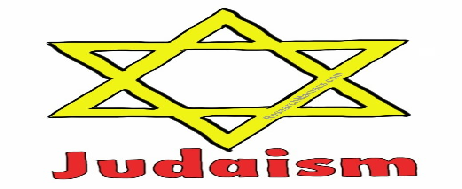
Jewish Law
& Tradition,
The Talmud,
Shulchan Aruch,
Daf Yomi
SHULCHAN ARUCH
SHULCHAN ARUCH
This 16th-century text by Joseph Caro is the ultimate code of Jewish law.
My Jewish Learning, Rabbi Jill Jacobs,
See also Layout of a Shulchan Aruch Page
Ask the average Jew where to learn about Jewish law, and you’ll probably be sent to the Bible or Talmud . Once there, you may find yourself a bit confused. The Bible includes many laws, but generally offers little explanation of the details of observance; the Talmud, on the other hand, includes an excess of detail, but also incorporates multiple viewpoints, stories, and digressions.
A person wondering, for example, how to light a Hanukkah menorah, what activities are permitted on Shabbat , or what one may eat during Passover, will have to weed through pages of discussion in order to find answers, and those may not be straightforward at all.
Given the Talmud’s complexity, scholars since the medieval period have attempted to codify Jewish law in an easily accessible format. In the 12th century, Moses Maimonides (Rambam) composed the Mishneh Torah, a summary of laws relating to all areas of Jewish life. This work, written in simple Hebrew, is meant to be accessible for the average Jew who does not have the skills or motivation to access Talmud.
A century later, Jacob ben Asher produced the Arba’ah Turim (often called the Tur for short), a code that addresses only the practical areas of Jewish law. Unlike Maimonides, Jacob ben Asher restricted his discussion to laws relevant to post-Temple Jewish life, and cited his sources, referencing different opinions when necessary.
THE SHULCHAN ARUCH’S BEGINNINGS
On the heels of the Tur, the next influential Jewish code of law was the Shulchan Aruch (literally, the “set table”), written by Joseph Caro (1488-1575). Caro was part of a Sephardic family that was expelled from Spain in 1492. After the death of his father, Caro was adopted by his uncle, Isaac Caro, the author of a commentary on the Bible. The Caro family eventually settled in Safed, the area of northern Israel where the mystical circle of Isaac Luria then flourished. Both Isaac and Joseph Caro became part of this community of mystics.
Joseph Caro originally set out to write a commentary on the Arba’ah Turim that would cite sources not mentioned by Jacob ben Asher and that would often differ from the Tur’s conclusions. This commentary, named the Bet Yosef, reads like a set of footnotes to Jacob ben Asher’s more concise statements of law.
In the introduction to this work, Caro explains that the expulsion of the Jews from Spain and their subsequent dispersion among Ashkenazic communities had caused confusion about the rules of observance. Sephardic Jews often found that their inherited traditions differed from those of the Ashkenazi Jews into whose communities they had moved; with the dismantling of Sephardic communities, it was no longer clear who had authority to decide matters of law. By presenting all known sources on particular issues, Caro hoped to clear up this confusion.
The Bet Yosef eventually became the notes for the Shulchan Aruch, which would become Caro’s most famous and influential work. Originally intended as a crutch for those not sufficiently learned to read the Bet Yosef or the halachic works referenced there, the Shulchan Aruch soon became the most important code of Jewish law.
FORMAT OF THE SHULCHAN ARUCH
Caro divided his work according to the categories introduced by Jacob ben Asher. Like the Arba’ah Turim, the Shulchan Aruch is divided into four sections:
Orah Hayim (laws relating to prayer, Shabbat and holiday observance, and other rituals of everyday life),
Yoreh De’ah (laws of kashrut, tzedakah, conversion, and other ritual matters),
Even ha’Ezer (laws relating to women and marriage), and
Hoshen Mishpat (civil law, including sections on lending money, renting and buying homes, and worker-employer relations).
Within each of these four sections, laws on similar subjects are grouped together. Each section is divided into simanim (paragraphs), and those are further divided into se’ifim (sub-sections). A citation of the Shulchan Aruch, thus, might read: Hoshen Mishpat 335:1, meaning: section Hoshen Mishpat, siman 335, se’if 1.
In general, the Shulchan Aruch presents laws in a straightforward way, with virtually no discussion. For example, Caro’s instructions for lighting Hanukkah candles read:
How many candles should one light? On the first night, one lights one; from then on, one adds one each night until there are eight on the last night (Orah Hayim 671:2).
Although the Talmud and other earlier texts include other traditions for the appropriate means of lighting Hanukkah candles, Caro chose to present only what he considered to be the correct procedure, in order to avoid confusing his readers.
CARO AND MYSTICISM
It may seem strange that Caro was simultaneously a mystic and the most important codifier of Jewish law. We tend to associate mystics with meditative practice and with an emphasis on achieving visions of the divine. When we imagine a medieval legal scholar, we might conjure up an image of a very serious man who spends his days bent over a set of musty books. However, within the context of the mystical circle of Safed, Caro’s double identity makes sense.
For Isaac Luria and his school, the goal of religious observance was to reunite the parts of the divine being that had been scattered as a result of human disobedience. This process, known as tikkun (fixing), required — first and foremost — the practice of mitzvot. Luria and his followers believed that the performance of each mitzvah helped in some way to unify the various aspects of God. The composition of a compendium of Jewish law would thus help Jews to participate in this tikkun.
For the most part, Caro’s mystical leanings have little effect on his legal decisions. In some instances, however, Caro does explain a particular law with reference to a mystical teaching.
COMMENTARIES ON THE SHULCHAN ARUCH
When Caro published the Bet Yosef, Rabbi Moshe Isserles (known as the Rema), an Ashkenazi legal scholar, responded with his own commentary on the Arba’ah Turim, called Darkhei Moshe. Learning that Caro was about to issue the Shulchan Aruch, Isserles abandoned this project and instead wrote a commentary on Caro’s work.
Isserles criticized Caro for often ignoring the opinions of Ashkenazic scholars, commenting that, “Caro’s books are full of decisions that do not follow the interpretations of the sages from whose waters we drink …[the sages] whose children’s children we are.”
It has become a familiar joke that every time a person claims to have the last word on Judaism, multiple commentators appear to challenge this assertion. Famously, Maimonides had the chutzpah to claim that a person could read the written Torah and then the Mishneh Torah and “from them, know the oral Torah and have no need to read another book.” Not surprisingly, Maimonides’ code did not become the last word in Jewish law, but rather almost immediately became the subject of numerous commentaries and critiques.
Similarly, the Shulchan Aruch did not immediately achieve widespread acceptance. Many scholars thought publishing a comprehensive code of law was forbidden, fearing that readers of such a code would have no way of knowing the history or range of opinions on various laws.
Rabbi Shlomo ben Yechiel Luria (the Maharshal), a contemporary of Caro’s, was the author of Yam shel Shlomo, a commentary on part of the Talmud. In the introduction to that work, the Maharshal declared the impossibility of “explain[ing] every uncertainty in the Torah to the point that there is no disagreement.” Rather, he argued, each scholar should delve into the sources, add new interpretations, and decide among various opinions.
ronically, the Shulchan Aruch ultimately gained its legitimacy through the publication of two major commentaries by 17th-century Ashkenazic scholars. These works, known as Turei Zahav (“Taz”) and Siftei Kohen (“Shakh”) and written by David ben Shmuel haLevi (Poland, 1586-1667) and Shabbetai ben Meir haKohen (Lithuania, 1621-1662), respectively, respond to the critiques of the Shulchan Aruch by explaining Caro’s reasoning, introducing alternative opinions, and offering their own conclusions.
In treating the Shulchan Aruch as an independent work worthy of a commentary of its own, rather than as the poor cousin of the more extensive Bet Yosef, these two scholars secured the place of the Shulchan Aruch as the authoritative code for generations to come.
The best-known later commentary on the Shulchan Aruch is the 19th-century Mishneh B’rurah, written by Yisrael Meir Kogan, which includes explanations and a collection of later opinions on the Orah Hayim section of the code. The 19th century also saw a number of attempts to abridge the Shulchan Aruch. The most famous of these is Shlomo Ganzfried’s Kitzur Shulchan Aruch, which summarizes Caro’s work while also incorporating some alternative opinions and contemporary customs.
INFLUENCE OF THE SHULCHAN ARUCH
To this day, the Shulchan Aruch remains the most influential code of Jewish law. Contemporary legal scholars may, on occasion, disagree with Caro’s conclusions, but they cannot ignore him. The proliferation of commentaries on the Shulchan Aruch has only solidified its central position in the canon. Almost 500 years after Caro produced a work intended primarily for those unable to study more complex legal works, his code has become the primary textbook for most traditional Jewish schools and yeshivas.
14 FACTS ABOUT THE CODE OF JEWISH LAW (SHULCHAN ARUCH)
Menachem Posner, Staff Editor, Chabad
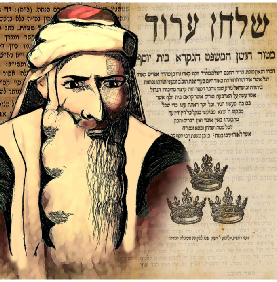
1. ITS HEBREW NAME MEANS ‘SET TABLE’
The Talmud contains 2,711 densely packed pages, full of involved discussions on all matters of Jewish law. In the years following its completion, countless comments, questions, and explanations were added by the various commentaries. Known in Hebrew as Shulchan Aruch (“Set Table”), the Code of Jewish Law lays out practical and concise instructions culled from the intricate web of Talmudic deliberation and rabbinic commentaries that come along with it.
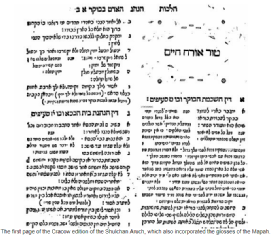 2. ITS CURRENT FORM IS A HYBRID OF SEPERATE TEXTS AUTHORED BY TWO MEN WHO NEVER MET
2. ITS CURRENT FORM IS A HYBRID OF SEPERATE TEXTS AUTHORED BY TWO MEN WHO NEVER MET
The Shulchan Aruch was written by Rabbi Yosef Caro (1488-1575), a Sephardic sage who lived in the holy city of Safed, in the north of Israel. At the same time that Rabbi Caro was completing his work, Rabbi Moshe Isserles, an Ashkenazi rabbi in Cracow, Poland, was working on a similar project.
Upon seeing the work of the Sephardic scholar, Rabbi Moshe chose to discard his manuscript and add glosses to the already-released text instead. He also notes wherever Ashkenazic tradition differs from the rulings codified by Rabbi Caro. Thus, a unified text was able to be used by all segments of the Jewish world.
3. THE COMMENTARY IS THE ‘CLOTH’
Keying off the name Shulchan Aruch, Rabbi Moshe called his commentary Mapah, which means “tablecloth.” In the words of his introduction: “I have come after [Rabbi Caro] to spread a cloth over the set table, upon which he has collected all the delightful fruits and delicacies that a person may love. For without this [addition], the table he has set before G-d was not placed before the people of these lands…”
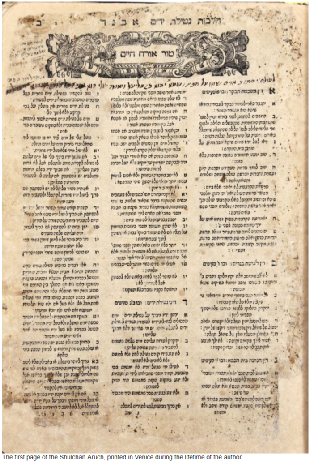 4. IT HAS FOUR PARTS
4. IT HAS FOUR PARTS
Rabbi Caro structured his work to mirror the Arba Turim (“Four Rows”) written by Rabbi Jacob ben Asher. It comprises four books, each dedicated to another area of Jewish life:
5. IT WAS NOT INTENDED TO BE A PRIMARY SOURCE
The author of Shulchan Aruch never intended that the work be used in isolation. Rather, he hoped that it would serve as a review for students of his lengthier commentary, the Beit Yosef, where the background and discussion behind many of his rulings are found.
6. IT WAS CONTROVERSIAL IN ITS DAY
When the Code of Jewish Law was first released, it received criticism reminiscent of the complaints lodged against Maimonides’ Yad Hachazakah. The fear was that people would become lazy, only consulting the sparse rulings of the Code, without bothering to understand the copious scholarship and nuance that stands behind every line.
There was also the initial concern that Rabbi Caro had based his rulings primarily on the teachings of Rabbi Isaac Alfasi (Rif), Maimonides, and Rabbi Asher ben Yechiel (Rosh), and did not represent the scholarship of the broader Jewish community. This concern was greatly assuaged by the glosses Rabbi Moshe Isserles added.
7. IT WAS FIRST PRINTED IN VENICE IN THE 1560’s
The first printing of the Shulchan Aruch was produced in Venice in approximately 1566, and included just the work of Rabbi Yosef Caro. The first edition to contain the teachings of both rabbis was printed in Cracow in 1578 (or earlier).
8. IT BEGINS WITH A WAKE-UP CALL
The first book of the Code of Jewish Law begins with the following exhortation: “He shall strengthen himself like a lion to rise in the morning to serve his Creator, Who wakes the dawn.” Rabbi Moshe adds a qualifying note, that at the very least one should not sleep past the time of communal prayers.
9. IT CONTAINS BOTH RASHI SCRIPT AND REGULAR SCRIPT
In the original Cracow edition, which included no commentaries, the words of both rabbis were printed in Rashi script, with the words of Rabbi Yosef Caro appearing slightly larger. In the standard editions of centuries since, Rabbi Caro’s words are printed in standard block script, with the additions of Rabbi Moshe Isserles in Rashi script, allowing the reader to easily discern between the two.
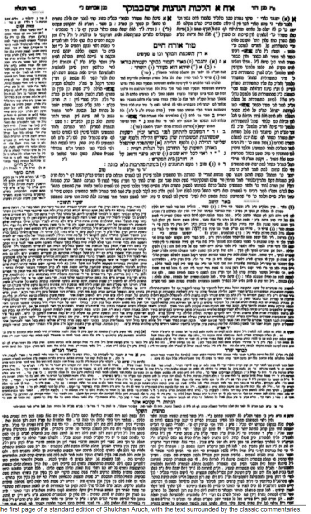 10. THE CODE IS NOW SURROUNDED BY COMMENTARIES
10. THE CODE IS NOW SURROUNDED BY COMMENTARIES
Many commentaries have been written on the Code of Jewish Law. Some of the most prominent ones have been printed on same page as the Code itself, including:
- Turei Zahav (Taz) by Rabbi David Halevi Segal (1586-1667) on the entire work.
- Magen Avraham by Rabbi Avraham Abbale Gombiner (1637-1682) on Orach Chaim.
- Siftei Kohen (Shach) by Rabbi Shabtai Kohen (1622-1662) on Yoreh Deah and Choshen Mishpat.
- Ketzot Hachoshen (Ketzos) by Rabbi Aryeh Leib Heller (1745-1812) on Choshen Mishpat.
- Ba’er Hetev summarizes the rulings of prior commentaries on the Shulchan Aruch.
11. THE ALTER REBBE WROTE ONE
In response to a request from his mentor, Rabbi Dov Ber, the Maggid of Mezritch, the Alter Rebbe (1745-1812), founder of Chabad Chassidism, composed his own version. Commonly known as Shulchan Aruch Harav, it takes into account the rulings of the Shulchan Aruch and many others, most notably the Magen Avraham. Although it follows the chapter divisions of Rabbi Caro’s work, the text is entirely reworked and significantly longer.
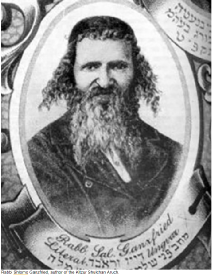 12. THE KITZUR SHULCHAN ARUCH IS NOT AN ABRIDGEMENT
12. THE KITZUR SHULCHAN ARUCH IS NOT AN ABRIDGEMENT
Rabbi Shlomo Ganzfried (1804-1886) wrote the very popular Kitzur Shulchan Aruch. Although its name means “Abridged Shulchan Aruch,” it is actually an original work, which clearly and succinctly spells out the basics of Jewish law in a manner that is easy for the layperson to understand.
Learn Kitzur Shulchan Aruch in Hebrew and English
13. MISHNAH BERURAH IS A POPULAR COMMENTARY
Rabbi Israel Meir Kagan (known as the Chafetz Chaim, 1839-1933) wrote a commentary to the Shluchan Aruch called the Mishnah Berurah (“Clear Study”). Printed along with the text of Orach Chaim, it fills six volumes.
14. IT IS SYNONYMOUS WITH JEWISH LAW
Although the totality of Jewish law is much broader than the Shulchan Aruch, the name has become synonymous. Hence, when one wishes to describe a Jew whose every move is in sync with halachah, one could use the moniker, a “Shulchan Aruch Yid.
SHULCHAN ARUCH
Wikipedia (Go to link for full article)
This article is about the work by Rabbi Yosef Karo.
For the work by Rabbi Schneur Zalman of Liadi, see Shulchan Aruch HaRav.
For the work by Lithuanian rabbi and posek Yechiel Michel Epstein, see Aruch HaShulchan.
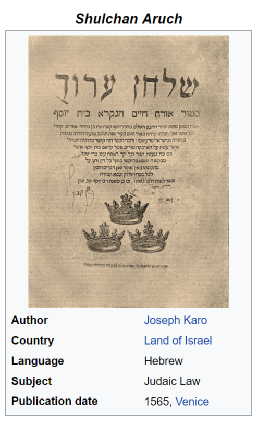 The Shulchan Aruch (Hebrew: שֻׁלְחָן עָרוּך [ʃulˈħan ʕaˈʁuχ], literally: "Set Table"), sometimes dubbed in English as the Code of Jewish Law, is the most widely consulted of the various legal codes in Judaism. It was authored in Safed (today in Israel) by Joseph Karo in 1563 and published in Venice two years later. Together with its commentaries, it is the most widely accepted compilation of Jewish law ever written.
The Shulchan Aruch (Hebrew: שֻׁלְחָן עָרוּך [ʃulˈħan ʕaˈʁuχ], literally: "Set Table"), sometimes dubbed in English as the Code of Jewish Law, is the most widely consulted of the various legal codes in Judaism. It was authored in Safed (today in Israel) by Joseph Karo in 1563 and published in Venice two years later. Together with its commentaries, it is the most widely accepted compilation of Jewish law ever written.
The halachic rulings in the Shulchan Aruch generally follow Sephardic law and customs, whereas Ashkenazi Jews will generally follow the halachic rulings of Moses Isserles, whose glosses to the Shulchan Aruch note where the Sephardic and Ashkenazi customs differ. These glosses are widely referred to as the mappah (literally: the "tablecloth") to the Shulchan Aruch's "Set Table". Almost all published editions of the Shulchan Aruch include this gloss, and the term "Shulchan Aruch" has come to denote both Karo's work as well as Isserles', with Karo usually referred to as "the mechaber" ("author") and Isserles as "the 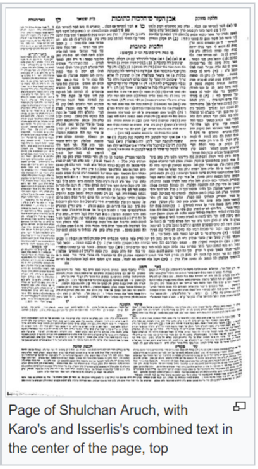 Rema" (an acronym of Rabbi Moshe Isserles).
Rema" (an acronym of Rabbi Moshe Isserles).
Beth Yosef
Its premise and style
Main article: Beit Yosef (book)
The Shulchan Aruch is largely based on an earlier work by Karo, titled Beth Yosef. Although the Shulchan Aruch is largely a codification of the rulings of the Beth Yosef, it includes various rulings that are not mentioned at all in the Beth Yosef, because after completing the Beth Yosef, Karo read opinions in books he hadn't seen before, which he then included in the Shulchan Aruch.[3] In his famous methodological work Yad Malachi, Malachi ben Jacob ha-Kohen cites a later halachic authority (Shmuel Abuhab) who reports rumors that the Shulchan Aruch was a summary of Karo's earlier rulings in Beth Yosef which he then gave to certain of his students to edit and compile. He concludes that this would then account for those seemingly self-contradictory instances in the Shulchan Aruch.[4]
The standard authorities
Karo initially intended to rely on his own judgment relating to differences of opinion between the various authorities, especially where he could support his own view based on the Talmud. But he abandoned this idea because, as he wrote:[5] "Who has the courage to rear his head aloft among mountains, the heights of God?" and also because he may have thought, though he does not mention his conclusion, that he could gain no following if he set up his authority against that of the ancient scholars.[citation needed] Hence Karo adopted the Halakhot of Rabbi Isaac Alfasi (the Rif), Maimonides (the Rambam), and Asher ben Jehiel (the Rosh) as his standards, accepting as authoritative the opinion of two of the three, except in cases where most of the ancient authorities were against them or in cases where there was already an accepted custom contrary to his ruling.[6] The net result of these last exceptions is that in a number of cases Karo rules in favour of the Catalan school of Nahmanides and Rashba, thus indirectly reflecting Ashkenazi opinions, even against the consensus of Alfasi and Maimonides. Karo very often decides disputed cases without necessarily considering the age and importance of the authority in question, expressing simply his own views. He follows Maimonides' example, as seen in Mishneh Torah, rather than that of Jacob ben Asher, who seldom decides between ancient authorities.
Several reasons induced Karo to connect his work with the "Tur", instead of Maimonides' code.
The "Tur", although not considered as great an authority as Maimonides' code, was much more widely known; the latter being recognized only among the Spanish Jews, while the former enjoyed a high reputation among the Ashkenazim and Sephardim, as well as the Italian Jews.
Karo intended to give not merely the results of his investigations (as Maimonides' code did), but also the investigations themselves.[7] He wished not only to aid the officiating rabbi in the performance of his duties, but also to trace for the student the development of particular laws from the Talmud through later rabbinical literature.
Unlike the Tur, Maimonides' code includes all fields of Jewish law, of both present-day relevance and those dealing with prior and future times (such as laws of sacrifices, Messiah, Kings, etc.). For Karo, whose interest lay in ruling on the practical issues, the Tur seemed a better choice.
Moses Isserles
The "Rema" (Moses Isserles) started writing his commentary on the Arba'ah Turim, Darkhei Moshe, at about the same time as Yosef Karo. Karo finished his work "Bet Yosef" first, and it was first presented to the Rema as a gift from one of his students. Upon receiving the gift, the Rema could not understand how he had spent so many years unaware of Karo's efforts. After looking through the Bet Yosef, the Rema realized that Karo had mainly relied upon Sephardic poskim.
In place of Karo's three standard authorities, Isserles cites "the later authorities" (chiefly based on the works of Yaakov Moelin, Israel Isserlein and Israel Bruna, together with the Franco-German Tosafists) as criteria of opinion.[8] While the Rosh on many occasions based his decision on these sources, Isserles gave them more prominence in developing practical legal rulings. By incorporating these other opinions, Isserles actually addressed some major criticisms regarding what many viewed as the arbitrary selection of the three authorities upon whose opinions Karo based his work.[9]
After realizing this, the Rema shortened his work on the Tur, entitled Darkhei Moshe, to focus only on rulings which differ from Bet Yosef.
The halachic rulings in the Shulchan Aruch generally follow the Sephardic custom. The Rema added his glosses and published them as a commentary on the Shulchan Aruch, specifying whenever the Sephardic and Ashkenazic customs differ. These glosses are sometimes referred to as the mappah, literally, the 'tablecloth,' to the Shulchan Aruch's 'Set Table.' Almost all published editions of the Shulchan Aruch include this gloss.
The importance of the minhag ("prevailing local custom") is also a point of dispute between Karo and Isserles: while Karo held fast to original authorities and material reasons, Isserles considered the minhag as an object of great importance, and not to be omitted in a codex. This point, especially, induced Isserles to write his glosses to the Shulchan Aruch, that the customs (minhagim) of the Ashkenazim might be recognized, and not be set aside through Karo's reputation.
LINKS
Moshe (Moses) Isserles: Rema Jewish Learning
BASIC TEXTS - 06 - THE SHULCHAN ARUCH
munahVersity 2018 (9.46)
Join Rav Daniel Ventresca as he speaks on a variety of topics of spiritual and practical interest to Converts/Gerim, Returnees/Baalei Tshuva and Noahides/Bnei Noach.
The Emunah Project. The Shulchan Aruch. Joseph Caro. Yosef Caro. Oral Law. Halakhah. Jewish Law.
Rabbi Moshe Isserles (The Rema)
This Week in Jewish History
Rabbi Moshe Isserles was an exceptionally important Polish Jew of the 16th century. His commentary on the Code of Jewish Law brought Sephardic and Ashkenazic Jewry together to an unprecedent
Rabbi Yosef Karo (Caro)
and the Code of Jewish Law
Jewish History Lecture
Dr. Henry Abramson 2012 (55.13)
Rabbi Yosef Karo, the author of the Code of Jewish Law.
|
|
|
|
|
